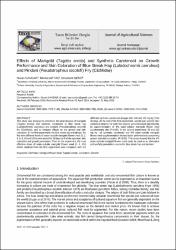| dc.contributor.author | Çavdar, Nuran | |
| dc.contributor.author | Aktaş, Mevlüt | |
| dc.contributor.author | Genç, Ercüment | |
| dc.date.accessioned | 2020-12-21T10:19:59Z | |
| dc.date.available | 2020-12-21T10:19:59Z | |
| dc.date.issued | 2020 | en_US |
| dc.identifier.citation | Cavdar, N , Aktas, M , Genc, E . (2020). Effects of Marigold (Tagetes erecta) and Synthetic Carotenoid on Growth Performance and Skin Coloration of Blue Streak Hap (Labidochromis caeruleus) and Pindani (Pseudotropheus socolofi) Fry (Cichlidae) . Journal of Agricultural Sciences , 26 (3) , 307-315.
https://doi.org/10.15832/ankutbd.523112 | en_US |
| dc.identifier.uri | https://doi.org/10.15832/ankutbd.523112 | |
| dc.identifier.uri | https://hdl.handle.net/20.500.12508/1530 | |
| dc.description.abstract | This study was designed to determine the ideal dosages of marigold (Tagetes erecta) and synthetic carotenoid in blue streak hap (Labidochromis caeruleus) and pindani (Pseudotropheus socolofi) fry (Cichlidae), and to compare effects on the growth and skin coloration. In the first experiment, the blue streak hap and pindani fry fed with different levels of water-soluble marigold flower meal (0, 2, 4, 6, 8, 10 and 12%) were tested for 30 days to find the optimum skin coloration and growth parameters. Then, in the experiment, the most effective doses of water-soluble marigold flower meal (2, 4, 8%) which obtained from the first experiment were compared with the different synthetic carotenoid dosages (50, 100 and 150 mg kg(-1)) for 30 days. At the end of the first experiment, weight gain and the skin coloration degrees for both fish species were increased significantly by supplementation of 4% water-soluble marigold flower meal supplemented diet (P<0.05). In the second experiment, 50 and 100 mg kg(-1) of synthetic carotenoid and 4% water-soluble marigold flower meal supplementation showed better performances concerning growth and skin coloration (P<0.05). This study showed that the 4% water-soluble marigold flower meal could be used as an alternative and useful pigmentation source for blue streak hap and pindani. | en_US |
| dc.language.iso | eng | en_US |
| dc.publisher | Ankara University | en_US |
| dc.relation.isversionof | 10.15832/ankutbd.523112 | en_US |
| dc.rights | info:eu-repo/semantics/openAccess | en_US |
| dc.subject | Cichlidae | en_US |
| dc.subject | Marigold flower meal | en_US |
| dc.subject | Tagetes erecta | en_US |
| dc.subject | Coloration | en_US |
| dc.subject | Growth | en_US |
| dc.subject.classification | Agriculture | |
| dc.subject.classification | Multidisciplinary | |
| dc.subject.classification | Astaxanthine | Pigmentation | Carotenoids | |
| dc.subject.other | Red-pepper | |
| dc.subject.other | Pigmentation | |
| dc.subject.other | Flower | |
| dc.subject.other | Astaxanthin | |
| dc.subject.other | Oleoresin | |
| dc.subject.other | Survival | |
| dc.subject.other | Goldfish | |
| dc.subject.other | Mykiss | |
| dc.subject.other | Fish | |
| dc.subject.other | Koi | |
| dc.title | Effects of Marigold (Tagetes erecta) and Synthetic Carotenoid on Growth Performance and Skin Coloration of Blue Streak Hap (Labidochromis caeruleus) and Pindani (Pseudotropheus socolofi) Fry (Cichlidae) | en_US |
| dc.type | article | en_US |
| dc.relation.journal | Tarım Bilimleri Dergisi | en_US |
| dc.contributor.department | Mühendislik ve Doğa Bilimleri Fakültesi -- Su Ürünleri Yetiştiriciliği Bölümü | en_US |
| dc.identifier.volume | 26 | en_US |
| dc.identifier.issue | 3 | en_US |
| dc.identifier.startpage | 307 | en_US |
| dc.identifier.endpage | 315 | en_US |
| dc.relation.publicationcategory | Makale - Uluslararası Hakemli Dergi - Kurum Öğretim Elemanı | en_US |
| dc.contributor.isteauthor | Çavdar, Nuran | |
| dc.contributor.isteauthor | Aktaş, Mevlüt | |
| dc.relation.index | Web of Science - Scopus - TR-Dizin | en_US |
| dc.relation.index | Web of Science Core Collection - Science Citation Index Expanded | |
















